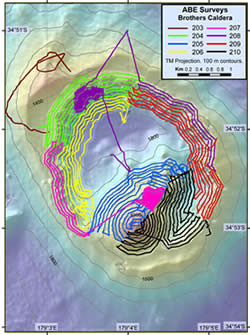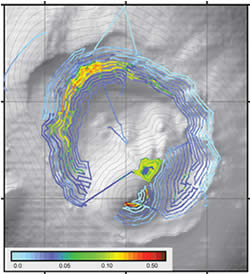Kermadec-Tonga Arc region
2007 AUV expedition to Brothers Volcano
In July-August 2007, we used ABE to survey Brothers volcano, located about 310 km NE of New Zealand along the magmatic front of the Kermadec arc. Brothers’ caldera has more than 300 m relief from a rim at ~1500 m to a maximum depth of 1880 m. Two major hydrothermal systems were discovered in the late 1990s, a high-temperature field (up to 302°C) on the NW wall and a lower temperature, gas-rich system on the summits of a pair of cones (reaching to 1200 m depth) in the SE half of the caldera. The caldera wall, the cones, and part of the flat caldera rim were mapped in 96 hours of survey time over 8 dives with 50-60 m trackline spacing at an altitude of 50 m above the seafloor. Hydrothermal plumes were mapped with ABE's integrated CTD (Conductivity- Temperature-Depth) and sensors measuring optical backscatter (particle concentrations) and oxidation-reduction potential (ORP; indicating the presence of reduced chemical species). This survey resulted in the first high-resolution map of temperature, particle, and ORP anomalies within a hydrothermally active submarine caldera. New details about the extent and structure of the known active vent fields were revealed, and a new area of active venting was discovered along the west caldera wall. These new data, along with the previously collected suites of fluid, mineral and seafloor observations, provide a baseline for future monitoring of Brothers' hydrothermal and volcanic activity. It will also provide a better understanding of how the long-term interplay of hydrothermal and volcanic activity affects the geomorphic evolution of submarine arc volcanoes.
Embley, R. W., C. de Ronde, B. Davy, E.T. Baker, J.A. Resing, D.R. Yoerger, S.G. Merle, and S.L. Walker (2007), Preliminary results of a near-bottom integrated seafloor and water column survey of Brothers volcano, Kermadec arc, using the autonomous vehicle ABE, Eos Trans. AGU, 88(52), Fall Meet. Suppl., Abstract V34B-07.
Walker, S.L., E.T. Baker, C.E. de Ronde, D. Yoerger, R.W. Embley, B. Davy, S.G. Merle, J.A. Resing, and K. Nakamura (2008), High-resolution distribution of temperature, particle and oxidation/reduction potential anomalies from a submarine hydrothermal system: Brothers Volcano, Kermadec Arc, Eos Trans. AGU, 89(53), Fall Meet. Suppl., Abstract V41B-2077.


